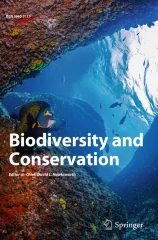Please find all scientific publications of IGB under > scientific publications
For more detailed information please refer to our > library catalogue
1 - 10 of 93 items
- Department:(Dept. 4) Fish Biology, Fisheries and Aquaculture

March 2025
Aquaculture Reports. - 42(2025), Art. 102732
European perspectives on Litopenaeus vannamei aquaculture: An expert’s survey
Paolo Gamberoni; Sven Wuertz; David Bierbach; Mirko Bögner; Matthew James Slater

March 2025
Royal Society Open Science. - 12(2025)3, Art. 241055
Collective escape waves provide a generic defence against different avian predators
David Bierbach; Juliane Lukas; Luis Gómez-Nava; Fritz A. Francisco; Lenin Arias-Rodriguez; Stefan Krause; Korbinian Pacher; Yunus Sevinchan; Pawel Romanczuk; Jens Krause

March 2025
PNAS Nexus. - XX(2025)X, Art. pgaf078
The future potential of controlled environment agriculture
Vanesa Calvo-Baltanás; Andreas Vilcinskas; Thomas Brück; Werner Kloas; Thomas Wilke; Mariana Rufino; Marius Henkel; Holger Zorn; Oscar Monje; Senthold Asseng

March 2025
Fisheries. - XX(2025)XX, XX-XX
Individual outcomes matter in the context of responsible and sustainable catch-and-release practices in recreational fisheries and their management
Steven J. Cooke; Sascha C. Danylchuk; Sean R. Tracey; Robert Arlinghaus; Robert J. Lennox; Jacob W. Brownscombe; Adam Weir; Scott G. Hinch; David A. Patterson; Meaghan L. Guckian; Andy J. Danylchuk

March 2025
Biodiversity and Conservation. - XX(2025)X, XX-XX
Rare fish species in European lakes – patterns and processes
Thomas Mehner; Christine Argillier; Teresa Ferreira; Kerstin Holmgren; Erik Jeppesen; Fiona Kelly; Teet Krause; Mikko Olin; Pietro Volta; Ian J. Winfield; Sandra Brucet
February 2025
Conservation Biology. - XX(2025)X, XX-XX
Amphibian conservation in Europe: the importance of pond condition
A. López‑de Sancha; D. Boix; L. Benejam; L. Briggs; T. A. Davidson; J. C. Fahy; V. Frutos‑Aragón; H. M. Greaves; P. Lemmens; T. Mehner; L. Martín; B. Oertli; C. Sayer; S. Brucet

January 2025
Water. - 17(2025)3, Art. 397
Aquaculture Development in Myanmar: Aquaculture Quo Vadis?
Sven Wuertz; Florian Muehlbauer

January 2025
Journal of Hazardous Materials. - 488(2025), Art. 137260
Freshwater browning as a hidden threat – Transcriptomic responses in fish gills exposed to fulvic acid
Thora Lieke; Verena Jung-Schroers; Alexander Rebl
January 2025
Ecography. - XX(2025)XX, Art. e07347
Drivers of amphibian species richness in European ponds
Alejandro López-de Sancha; Lluís Benejam; Dani Boix; Lars Briggs; Maria Cuenca-Cambronero; Thomas A. Davidson; Luc De Meester; Julie C. Fahy; Pieter Lemmens; Beatriz Martin; Thomas Mehner; Beat Oertli; Marzenna Rasmussen; Helen M. Greaves; Carl Sayer; Meryem Beklioğlu; Rein Brys; Sandra Brucet
January 2025
Biological Conservation. - 302(2025), Art. 110983
Stakeholder workshops on western Baltic cod fisheries–conflict and consensus in the face of a highly dynamic ecosystem
W.-C. Lewin; M.E. Pierce; R. Arlinghaus; M.S. Weltersbach; H.V. Strehlow




